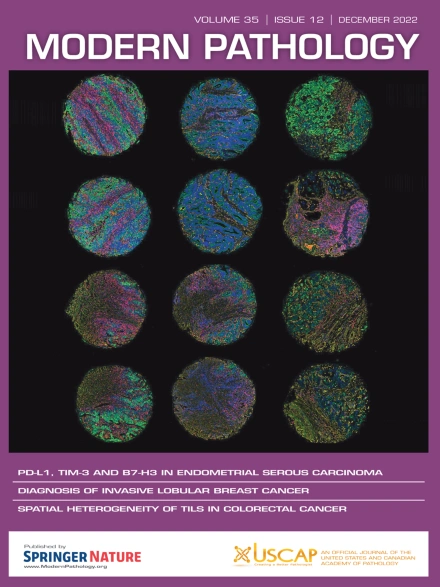弥漫性大b细胞淋巴瘤/高级别b细胞淋巴瘤伴MYC和BCL6重排60例分析
IF 7.1
1区 医学
Q1 PATHOLOGY
引用次数: 0
摘要
弥漫性大b细胞淋巴瘤(DLBCL)/高级别b细胞淋巴瘤(HGBL)合并MYC和BCL6重排,也称为BCL6双击淋巴瘤(DHL),其分类存在争议。我们评估了60例BCL6-DHL,并将该队列与224例伴有MYC和BCL2重排的DHL (BCL2-DHL)和217例未作其他说明的DLBCL进行比较。与DLBCL患者相比,BCL6-DHL患者具有更积极的临床特征,如淋巴结外频繁受累、疾病分期高、IPI评分高、血清乳酸脱氢酶水平升高(p本文章由计算机程序翻译,如有差异,请以英文原文为准。
Diffuse Large B-Cell Lymphoma/High-Grade B-Cell Lymphoma With MYC and BCL6 Rearrangements: A Study of 60 Cases
Classification of cases of diffuse large B-cell lymphoma (DLBCL)/high-grade B-cell lymphoma (HGBL) with MYC and BCL6 rearrangements, referred to here as BCL6 double-hit lymphoma (DHL), is controversial. We assessed 60 cases of BCL6-DHL and compared this cohort to 224 cases of DHL with MYC and BCL2 rearrangements (BCL2-DHL) and 217 cases of DLBCL not otherwise specified. Compared with the DLBCL cohort, patients with BCL6-DHL had more aggressive clinical features such as frequent extranodal involvement, high-stage disease, a high International Prognostic Index score, and an elevated serum lactate dehydrogenase level (P < .01 for all). Compared with the BCL2-DHL cohort, patients with BCL6-DHL had similarly aggressive clinical features but a lower frequency of germinal center B-cell (GCB) immunophenotype and MYC and BCL2 double expression. Patients with BCL6-DHL showed overall survival (OS) intermediate between patients with DLBCL and BCL2-DHL. Following induction with rituximab, cyclophosphamide, doxorubicin, vincristine, and prednisone (R-CHOP) chemotherapy, patients with BCL6-DHL demonstrated poor OS similar to patients with BCL2-DHL and worse OS than that of patients with DLBCL (P = .024). However, among patients who received rituximab, etoposide phosphate, prednisone, vincristine, cyclophosphamide, and doxorubicin (R-EPOCH), there was no significant difference in OS among the 3 groups (P = .146). Gene expression profiling showed that 60% of BCL6-DHL cases had a double-hit (DH)-like signature compared with 10% of DLBCL-GCB and 93% of BCL2-DHL cases. The DH-like signature in BCL6-DHL cases was associated with a GCB immunophenotype. Based on these data, we suggest that BCL6-DHL cases are clinically more aggressive than DLBCL and patients may benefit from a more aggressive therapy than R-CHOP. The data also suggest that BCL6-DHL, as currently defined, is heterogeneous and that neoplasms with a GCB immunophenotype are more likely to have a DH-like signature and behave more aggressively. Last, we suggest that BCL6-DHL cases deserve to be recognized separately in a lymphoma classification to facilitate further understanding of these neoplasms and for optimal patient management.
求助全文
通过发布文献求助,成功后即可免费获取论文全文。
去求助
来源期刊

Modern Pathology
医学-病理学
CiteScore
14.30
自引率
2.70%
发文量
174
审稿时长
18 days
期刊介绍:
Modern Pathology, an international journal under the ownership of The United States & Canadian Academy of Pathology (USCAP), serves as an authoritative platform for publishing top-tier clinical and translational research studies in pathology.
Original manuscripts are the primary focus of Modern Pathology, complemented by impactful editorials, reviews, and practice guidelines covering all facets of precision diagnostics in human pathology. The journal's scope includes advancements in molecular diagnostics and genomic classifications of diseases, breakthroughs in immune-oncology, computational science, applied bioinformatics, and digital pathology.
 求助内容:
求助内容: 应助结果提醒方式:
应助结果提醒方式:


